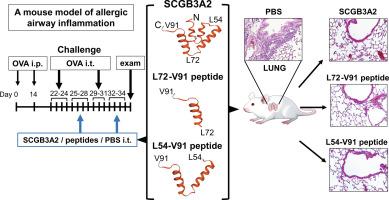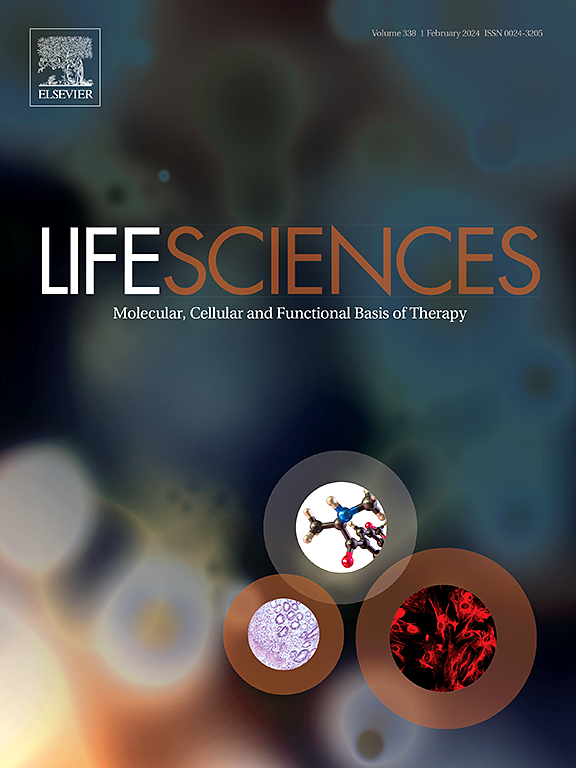分泌型血红蛋白 3A2 肽具有治疗过敏性气道炎症的潜力。
IF 5.2
2区 医学
Q1 MEDICINE, RESEARCH & EXPERIMENTAL
引用次数: 0
摘要
分泌型血红蛋白(SCGB)3A2有三种异构体,即A型、B型和C型,通过替代剪接在内源性产生。SCGB3A2 A型是正确剪接的主要类型,从小鼠胚胎第11.5天开始表达,具有多种生理活性,如促进肺成熟和支气管分支、抗炎作用以及改善诱导性肺纤维化。为了研究 SCGB3A2 多肽治疗呼吸系统疾病的潜力,本研究合成了 9 个连续重叠的多肽,涵盖了整个 C 型异构体,以及分别涵盖 A 型和 B 型 C 端区域的 5 个和 1 个多肽。为了评估它们的生物活性,每种肽都在体外用小鼠肺成纤维细胞衍生的 MLg 细胞进行了细胞增殖和凋亡分析,在体外用小鼠胎肺器官培养物进行了支气管分支率分析,在体内用过敏性气道炎症小鼠模型进行了分析。在 A 型肽和 C 型肽中,与 SCGB3A2 序列 C 端区域相对应的肽具有促进细胞增殖、支气管分支和/或抑制细胞凋亡的独特生物活性。B 型肽没有显示出任何增殖作用,但抑制了细胞凋亡。在过敏性气道炎症的小鼠模型中,服用大部分源自 C 端区域的 A 型肽和 C 型肽都能改善肺部炎症。这些结果表明,SCGB3A2序列的生物活性存在于C端区域,覆盖该区域的多肽可用作治疗肺部炎症的药物。本文章由计算机程序翻译,如有差异,请以英文原文为准。

Secretoglobin 3A2 peptides have therapeutic potential for allergic airway inflammation
Three isoforms of secretoglobin (SCGB) 3A2, namely type A, B, and C, are endogenously produced through alternative splicing. SCGB3A2 type A, the correctly spliced major type, begins to be expressed from embryonic day 11.5 in mice and shows various physiological activities such as promoting lung maturation and bronchial branching, anti-inflammatory effects, and ameliorating induced pulmonary fibrosis. To investigate the potential of SCGB3A2 peptides as a therapeutic to treat respiratory diseases, in this study, serially overlapping nine peptides were synthesized to cover the entire type C isoform, and five and one peptides covering the C-terminal region of type A and B, respectively. To evaluate their biological activities, each peptide was subjected to cell proliferation and apoptosis analyses in vitro using mouse lung fibroblast-derived MLg cells, bronchial branching rate using ex vivo mouse fetal lung organ cultures, and in vivo allergic airway inflammation mouse model. Among type A and C peptides, those corresponding to the C-terminal region of the SCGB3A2 sequence exhibited its unique biological activities of promoting cell proliferation and bronchial branching, and/or inhibiting apoptosis. The type B peptide did not show any proliferative effect while inhibited apoptosis. In a mouse model of allergic airway inflammation, lung inflammation was improved by the administration of most of the C-terminal region-derived type A and type C peptides. The results suggest that the bioactivity resides towards the C-terminal region of SCGB3A2 sequence, and the peptides covering this region could be used as a therapeutic in treating lung inflammation.
求助全文
通过发布文献求助,成功后即可免费获取论文全文。
去求助
来源期刊

Life sciences
医学-药学
CiteScore
12.20
自引率
1.60%
发文量
841
审稿时长
6 months
期刊介绍:
Life Sciences is an international journal publishing articles that emphasize the molecular, cellular, and functional basis of therapy. The journal emphasizes the understanding of mechanism that is relevant to all aspects of human disease and translation to patients. All articles are rigorously reviewed.
The Journal favors publication of full-length papers where modern scientific technologies are used to explain molecular, cellular and physiological mechanisms. Articles that merely report observations are rarely accepted. Recommendations from the Declaration of Helsinki or NIH guidelines for care and use of laboratory animals must be adhered to. Articles should be written at a level accessible to readers who are non-specialists in the topic of the article themselves, but who are interested in the research. The Journal welcomes reviews on topics of wide interest to investigators in the life sciences. We particularly encourage submission of brief, focused reviews containing high-quality artwork and require the use of mechanistic summary diagrams.
 求助内容:
求助内容: 应助结果提醒方式:
应助结果提醒方式:


